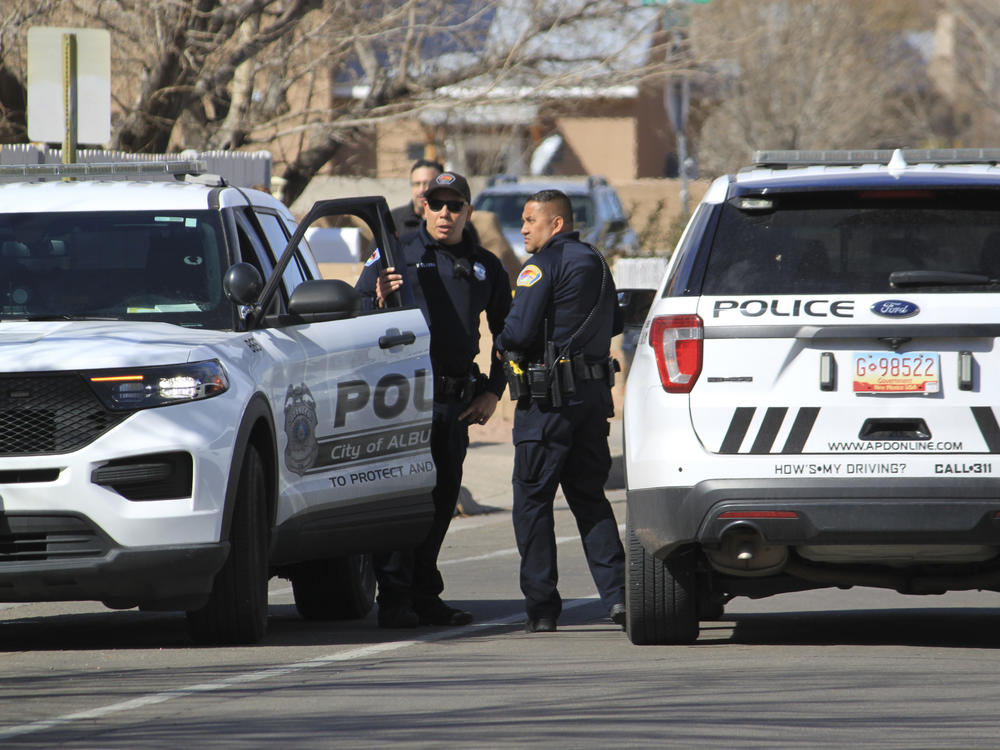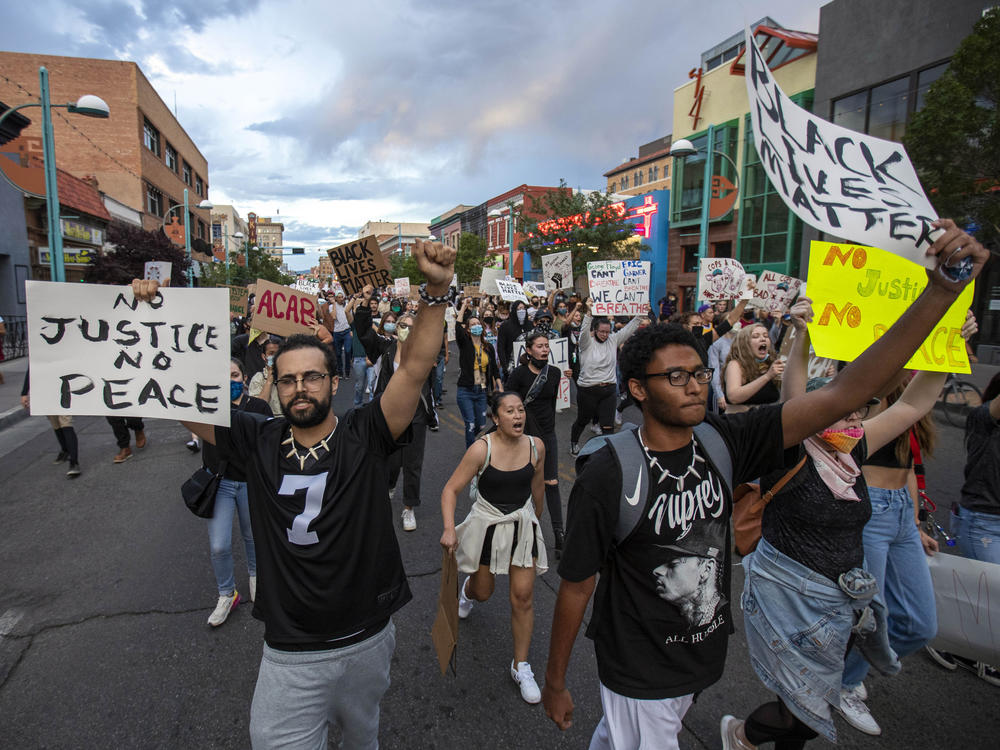Section Branding
Header Content
Why New Mexico has one of the highest rates for killings by police
Primary Content
Last week, officers with the Farmington, N.M., Police Department responded to a call of a domestic violence incident. Police mistakenly arrived at the wrong house and shot and killed Robert Dotson after he opened his door armed with a handgun.
New Mexico State Police are still investigating the incident, but the fatal shooting of the 52-year-old is just the latest example of police using lethal force against civilians in a state where this happens too frequently, critics say.
Home to about 2.1 million people, New Mexico has one of the highest rates of police killings per capita in the country.
Last year, 32 people — around 15 people per million — were killed by police in the state, according to data from MappingPoliceViolence.org. The project is part of Campaign Zero, a nonprofit focused on policing reform.
New Mexico is second to Wyoming, with a population of about 581,000, where around 17 people per million were killed by police.
"Who would have thought New Mexico would have one of the highest rates in the country?" said Howard Henderson, founding director of the Center for Justice Research at Texas Southern University. He's also a professor in the university's school of public affairs.
In New Mexico, the rate of police using lethal force is even higher if a Black resident is involved. Black people total around 2.7% of the state's population, yet they are nearly four times more likely to be killed by police than white people. Years of high-profile cases of Black people killed by police across the country show this is an ongoing problem due in part to racial bias in policing.
MappingPoliceViolence.org data reflects any incident where a law enforcement officer (off-duty or on-duty) applies lethal force resulting in a civilian being killed. This is whether the killing was considered "justified" or "unjustified" by law enforcement.
Critics of police response in New Mexico say a bigger gun culture in the state compared to much of the rest of the country and lax police training play a factor in the high incidence of police killings.
Police in the state's largest cities say they are making changes to alter how police use lethal force.
The death in Farmington "and others like it make clear the urgent need for statewide police reform," Barron Jones with the ACLU New Mexico said in a news release.
"We know that commonsense policies like requiring de-escalation and a high standard for when to use force keep all of us safer," Jones said. "Despite New Mexico having one of the highest, if not the highest, per capita rate of killings by police in the nation, robust legislation addressing police use of force did not pass this year. It doesn't have to be this way."
Gun ownership and culture play a factor
As of 2021, there were 122,968 federally registered firearms in the state, according to the Bureau of Alcohol, Tobacco, Firearms and Explosives. The data is collected under the National Firearms Act, but this reflects only a subsection of weapons.
Using data from the Rand Corp., CBS News reported that roughly 46% of adults in New Mexico had at least one gun at home in 2021. The state ranked 21st in a list of states and gun ownership. Texas, with more than 1 million gun licenses and roughly 46% of adults reporting they live in a home with guns, ranked first.
Most of New Mexico "is rural, people rely on self protection" and there's more of a culture of hunting compared to the rest of the country, so high gun ownership makes sense, said Maryam Ahranjani, a law professor at the University of New Mexico.
But this likely plays a role in higher levels of fatal use of force by police. Officers are more likely going to respond to a call assuming an individual may be armed, Ahranjani said.
And in the case in Farmington, after the initial shooting of the victim, Dotson, his wife fired at officers from the doorway of the residence, according to the state police. She stopped once she realized the people outside her house were police.
"It makes sense from a personal safety standpoint that officers want to keep themselves safe too," Ahranjani said.
Local critics says there is a police training problem in New Mexico
Because of the state's high gun ownership, Ahranjani said police should be trained in a way that prepares them to de-escalate situations rather than use lethal force.
For many years, the Albuquerque Police Department, the law enforcement agency in the state's largest city, has had difficulties with its officers' use-of-force. It has been investigated by the U.S. Justice Department for its pattern of excessive force. Federal officials reached an agreement with the city to improve training and to keep tabs on its progress.
Following the federal consent decree, the department has shown that "97% of use-of-force incidents were within policy during the most recent monitoring period," Gilbert Gallegos, a spokesman for the Albuquerque Police Department, told NPR.
"The vast majority of these incidents in the last 5 years have been found to be within policy. For shootings that were out of policy, we have terminated some officers," Gallegos said. He didn't provide a number for terminated officers.
Earlier this year, the police department announced additional ways to adopt a policy of less-lethal-force. That includes increased supervision by superiors and more protective equipment for officers. The changes were unveiled in March following a review of all 18 officer-involved shootings in 2022.
The department has also added more training for officers "so they are aware of the different options that exist," said Deputy Chief Cori Lowe, the deputy chief of APD's Accountability Bureau, in a statement in March. "We want officers to learn from the experiences of their peers and be prepared to respond to encounters in the most effective and appropriate manner."
The department has improved enough following its agreement with the DOJ that federal officials announced this week proposed plans to alter the deal.
But Jones, a senior policy strategist with the New Mexico ACLU, told NPR there needs to be a standardized policy for use of force across all of the state's law enforcement agencies.
"There's a hodgepodge of policies from Farmington, New Mexico, all the way down to southern New Mexico in Las Cruces," Jones said. "That could have something to do with [the higher levels of deadly use of force by police]."
Under state law, all police officers in New Mexico are required to complete in-service training twice a year and report this to the state. But, according to a 2021 analysis provided by the New Mexico ACLU, during the during the last biannual training cycle "only 47 % of law enforcement agencies complied with state reporting requirements, with over half of agencies' compliance with statutory training requirements unclear."
"We've learned that there's been situations where officers are out there patrolling the streets without having the requisite training or license," Jones said.
The nonprofit is pushing for legislation that would prohibit police in New Mexico from using force unless they're in imminent danger, he said.
Ahranjani urged better training on dealing with citizens struggling with mental health crises, especially.
"Those are folks who can't really advocate for themselves in the same way that maybe others would be able to," she said.
In recent years, many advocates have said law enforcement shouldn't be the ones responding to mental health-related calls.
A review of Albuquerque Police Department shootings between 2018 and 2022 showed that deadly force was used when attempting to apprehend violent suspects, when citizens were experiencing a mental health episode, or when people were acting badly while under the influence of drugs or alcohol, the city's police chief said in November.
In search of a solution Albuquerque developed a specialized department staffed to react with a non-law enforcement-led response to 911 calls related to mental health, substance use and homelessness.
Tracking the full scope of police use of force is a bit of a black hole
Understanding the full scope of fatal use of force by police nationwide is difficult.
"The interesting part about all of that is when you look at what's happening [in New Mexico], that's just what we know about. That's not even what we don't know," said Texas Southern's Henderson.
Many data sources on police use of force rely on voluntary reporting from the nation's more than 18,000 law enforcement agencies. And the federal database on police use of force has had very low participation from various agencies.
In New Mexico, a study found that "more than one-quarter of the people killed by police in the state were not included in official counts over the last four decades," Source New Mexico reported in 2021.
Ahranjani said, "I think there are instances [of police violence] that happen every day to people that don't go reported."
Copyright 2023 NPR. To see more, visit https://www.npr.org.


